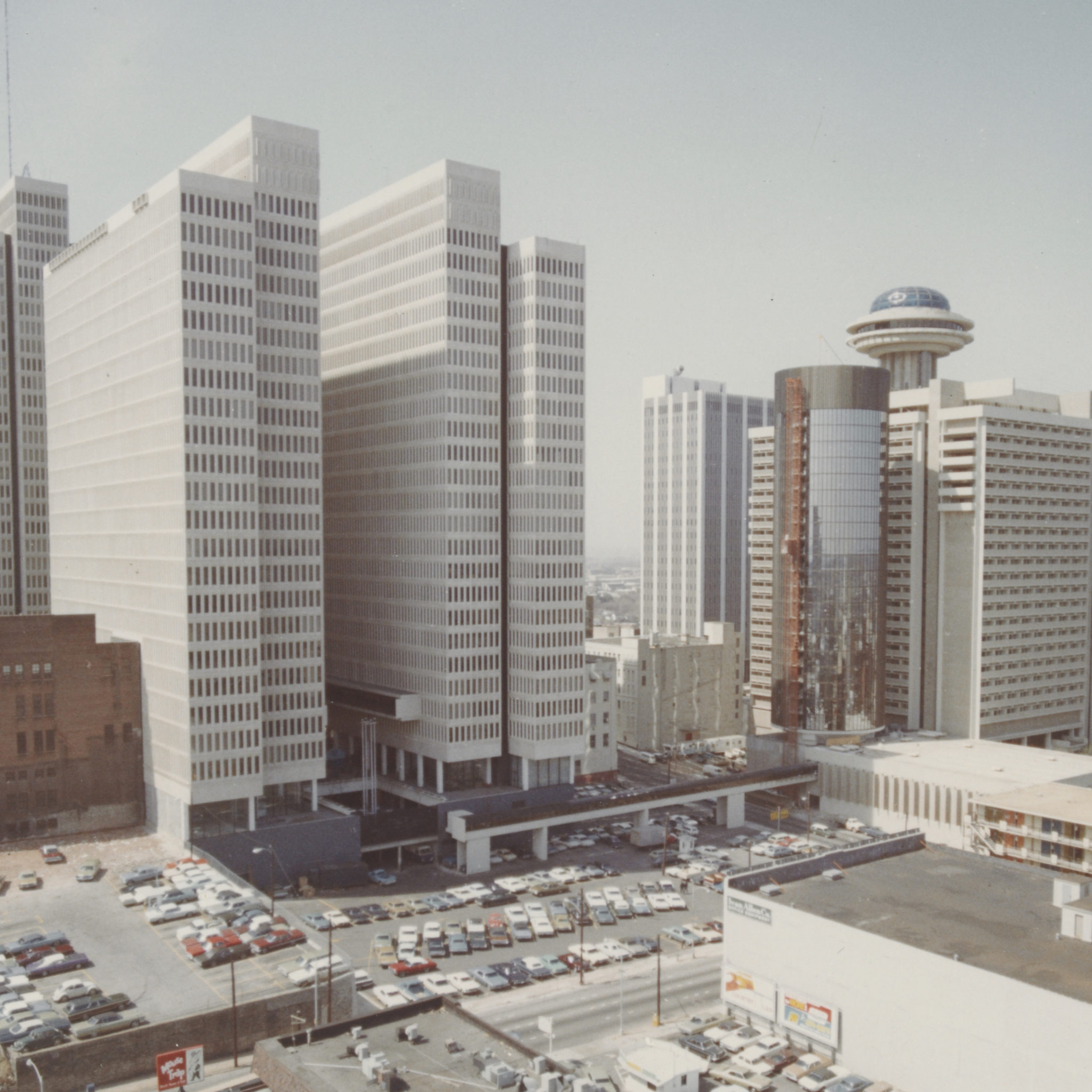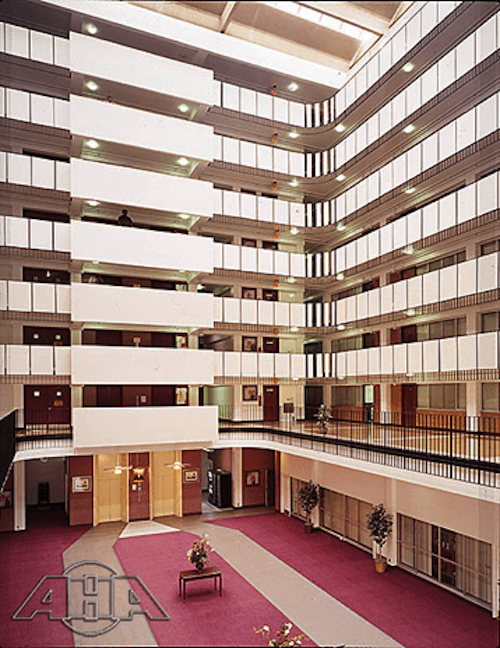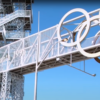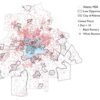In 1974, architectural critic Ada Louise Huxtable remarked, somewhat acerbically, about the construction boom in the heart of Atlanta:
This is Instant City. Downtown Atlanta has been built in the last ten years. What you see in the mile-and-a-half of Atlanta’s business here is what you get: a concentration of totally new office towers, hotels, shipping facilities, landscaped streets, plazas, and parks that are a product of the ‘60s and ‘70s – an incredibly unified achievement in an unbelievably short time, when other cities were struggling with piecemeal renewal. 1
Huxtable was talking not only about the pace and intensity of development in downtown Atlanta, but about the form that that development had taken as well. Specifically, downtown Atlanta’s sudden development had predominantly come in the form of large, privately financed, multi-use complexes. While city officials, white elite downtown businessmen, the city’s professional African American middle class, and intown neighborhood housing advocates butted heads over how to define, implement, and control federally-sponsored Urban Renewal,2 a cadre of architects and real estate developers had eschewed federal money and instead pursued the construction of several private revitalization projects, “cities within the city,” proudly exclaiming that “they hadn’t had a cent of federal money.”3 Criticizing Atlanta’s earlier “hodgepodge” approach to urban renewal, some local architect-developers publicly referred to the city’s previous urban renewal projects as failures.4 In the 1960s, Atlanta’s economic and political elites grew increasingly frustrated with federal urban renewal requirements, particularly that of citizen participation, which sought to please a broad political constituency that rarely agreed on renewal goals. By the decade’s end, the city’s biracial power coalition had increasingly abandoned such federal programs in favor of supporting public-private partnerships with these designer-developers.
Foremost among the city’s architect-developers was John Portman who called for the creation of an entirely new complex on the northeastern edge of downtown that would eventually become a “city within a city.” Portman had attributed “the discovery of the wheel (i.e. the automobile) … to the breakdown of cities.”5 Thus, in order to fix cities, he argued, a coalition of private entrepreneurs and local politicians needed to support redevelopment plans that could take people from their cars in the suburbs, bring them back to the city, and back onto their own two feet – as he argued that his proposed multi-purpose complex could. Portman envisioned bringing people back to the city, but his plans glossed over which “people” Portman anticipated inhabiting his new space. The privatized revitalization campaign Portman led increasingly emphasized improvements to the physical built environment at the expense of improvements for the lives of many Atlantans already residing nearby his proposed developments, a move that perpetuated the same political, economic, and racial inequalities that had first inspired urban renewal programs decades earlier.
“Urban renewal,” defined broadly, includes the crucial but largely under-recognized history of such private and quasi-private downtown redevelopment projects in the remaking of Atlanta’s downtown. Using such an expanded definition allows for an examination of an ambitious multi-purpose project that epitomized this private trend in urban development in the city and which remains central to downtown Atlanta today: John Portman’s Peachtree Center. His vision for and construction of this complex in downtown Atlanta between the 1960s and the mid‐1980s was revolutionary at the time, in part because Portman was “betting on the central business district while most developers looked out to the suburbs.”6 In so doing, he also notably opted out of federal renewal funding in order to exert more control over the direction and timing of his projects.
Ultimately, though, in spite of his publicized and celebrated openings and expansions, Portman’s projects did not spell a rebirth for many Atlanta residents. While the architect‐developer was right to suggest that car congestion, interstate construction, and suburban developments had led many affluent Atlantans, white and black, to abandon downtown Atlanta for suburban shops and offices, his prescription to fix cities and “bring life back to the streets,” underestimated the role that race, racial tensions, and the ongoing desegregation of the mid-1960s played in accelerating suburban sprawl and the depopulation and decline of downtown Atlanta. As Portman redeveloped downtown Atlanta, his architecture also subtly redefined who downtown was for. From Portman’s Merchandise Mart, to his office buildings, to the Hyatt Regency House and Peachtree Plaza hotels, Portman’s “city within a city” primarily served white collar business suburbanites, well-heeled tourists, and conventioneers – and its insular construction, replete with skywalks between the complex structures, brought little, if any new street life.7
Merchandise Mart
When John Calvin Portman graduated from the architecture program at nearby Georgia Institute of Technology in the 1950s, he believed that architectural design could make the world a better place. Interning with the design firm of Ketchum, Gina, and Sharp in New York City, Portman learned to think about how people reacted to their built environments. Early on, he also sought control over all aspects of his projects, convinced that his designs would have more lasting impact (not to mention more opportunities to be built) when he managed the real estate development end of things as well.8
The Georgia Tech architecture school graduate made his initial foray into downtown Atlanta development in the mid-1950s, just as Atlanta’s aldermen and downtown business associations were beginning to consider how and where to use federal urban renewal funding. Atlanta’s coalition of political and business leaders saw federal urban renewal as a means to clear blighted areas and shore up property values near the central business district, while intown neighborhood activists sought urban renewal funding to improve decaying housing stock in Atlanta’s poorest intown neighborhoods.9 Just as Atlanta’s first round of federal renewal project sites were underway, Portman was putting together his own ideas about how to revitalize Atlanta’s central core. He found an abandoned parking garage at the corner of Peachtree and Harris Streets, and he sought to convert it into an exhibition space. He envisioned a wholesale market for retailers: furniture manufacturers and interior design firms would have the space to showcase their latest pieces, and retail storeowners could place orders for wares to fill their stores. In Portman’s vision, if Atlanta maintained its status as a regional distribution center, storeowners from throughout the southeast would converge upon the city annually or bi‐annually to order stock.10 Thus, together with three partners, he proposed to renovate the 240,000 square foot garage into a furniture mart, one floor at a time. The garage sat on what many Atlantans in the 1950s would have considered a dead-end stretch of Peachtree Street, but Portman reasoned that its location would in no small part contribute to its success as a furniture mart located there would be within walking distance to all of the city’s major downtown hotels. The Mart group broke ground in 1959, and in July 1961, they opened the first Mart building, a twenty-three story, one million square foot structure, also known as the Merchandise Mart.
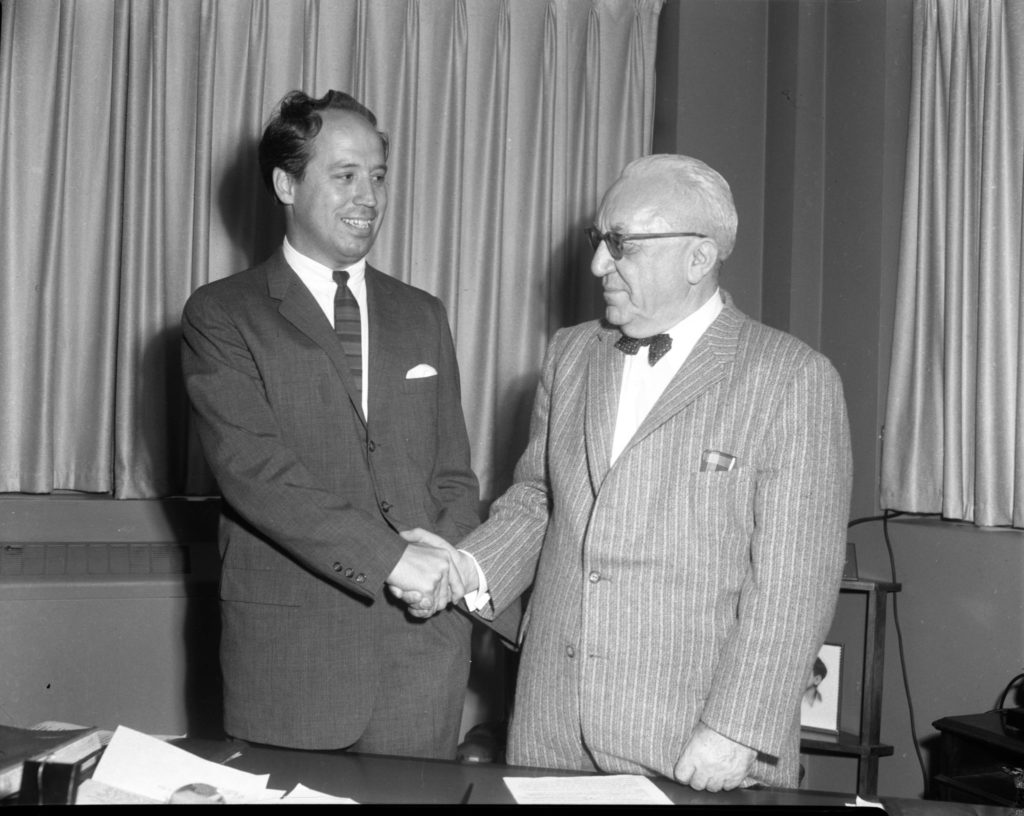
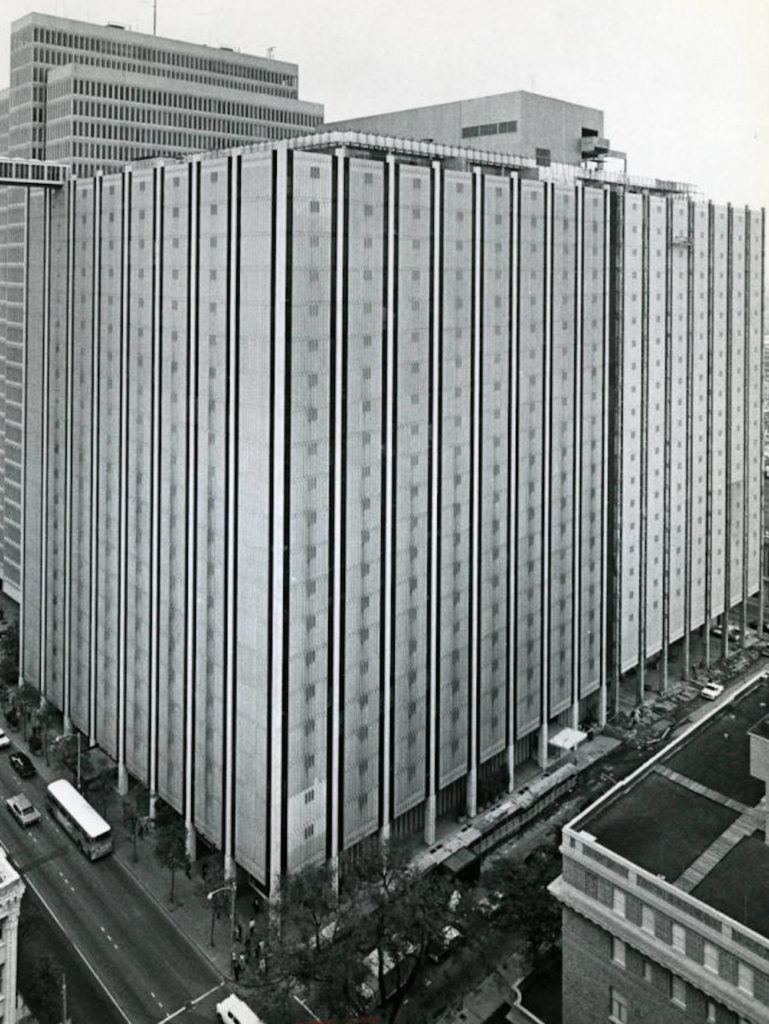
Gauging by foot traffic, the venture proved so successful that the young architect believed that the city could in fact support an even larger showroom. Though the Mart would always be privately owned, the Georgia State Legislature was considered a potential investor in Mart expansion because the state had long been debating construction on a state-owned convention center and integrating plans for a state convention center with the existing Mart space seemed like a natural first step. And as they pursued potential state financing for expansion, Portman and his associates emphasized the importance of the Mart’s existing proximity to downtown hotels and began fighting to ensure that an expanded Atlanta Mart Complex (and accompanying new hotels) could be built downtown.
Competing developers also understood the expansion possibilities, and especially the opportunity to win a state-financed construction contract for a combined Mart and convention center, but didn’t share Portman’s enthusiasm for keeping the project in downtown Atlanta. Of all the competing developers, one of the most persuasive was developer Robert Holder who sought the state legislature’s blessing to create a new public-private joint venture mart out in Gwinnett County. Holder emphasized the ongoing deterioration in downtown Atlanta, and while he did not explicitly mention race as a factor that would detract from the appeal of an expansion of Portman’s mart, Holder pointed out that the proposed location was within walking distance of a couple of proposed urban renewal project sites, which were not coincidentally also displacing thousands of African Americans. Accordingly, Holder lobbied state legislators for mart relocation and expansion money with an economic argument, albeit one with racial undertones: it would be cheaper, and less complicated to assemble land to build out in Gwinnett County. However, Portman ultimately won the argument to keep and expand the mart downtown largely over the issue of financing. C&S bank president Mills Lane intervened on Portman’s behalf and convinced key legislators that the mart could be expanded solely with private funding.11 With Lane’s help, Portman secured mart financing from the Metropolitan Life Insurance Company and fellow Atlanta developer Ben Massell bought Portman the land for mart construction.12
The Mart’s construction demonstrated the relative ease and speed with which Portman, acting as designer, financier, planner, and builder, could move from vision to execution, and could develop, particularly in a “dead end” area of the downtown. Unlike with federal-funded urban renewal, Portman did not have to submit a federal application for a renewal project approval, nor did he have to wait for approval of preliminary or execution plans. Portman could also hire whom he wanted, without oversight from officials on the local, state, and federal level, and did not have to wait on disbursement of federal funding. Portman’s relative autonomy with the Mart construction meant that the Mart was completed much faster than the city’s three earliest urban renewal sites – Butler Street, Rawson-Washington, and University Center – were redeveloped.
“We could not allow just anything to happen up and down the block”: From Mart to Hyatt
After this initial success, Portman began to conceive of a larger, coordinated development, complete with offices, apartments, shops, hotels, and parking garages that all related to one another, and one in which the Merchandise Mart would become the keystone. For as the architect later explained, following the completion of the Mart he had realized: 13
Portman named his plan the Peachtree Center, and he pitched it as a “city within a city” that could make downtown Atlanta bustling and vital again – his own privately funded urban renewal project. And, Portman added, Peachtree Center would be aesthetically pleasing. He envisioned that the various structures within the Peachtree Center complex would resemble one another, repeating architectural features and motifs from one building and courtyard to the next, and that they could function as a single cohesive unit.14 Finally, Portman suggested that Peachtree Center would need to be built on a “scale determined by how far a man will walk on foot before he thinks about looking around for some wheels.”15
In part because the Mart was becoming so popular with out-of-town merchandise buyers, after designing and erecting the first office building in the Peachtree Center – an unremarkable thirty‐one story rectangular office building at 230 Peachtree Street Northeast – Portman next sought to add a hotel to the complex of buildings he was planning at 265 Peachtree Street, on a property diagonally northeast of the Merchandise Mart and across Peachtree Street.16 After a series of complications, including multiple labor strikes and a merry-go-round of investors,17 Portman’s hotel, the Regency Hyatt House, finally opened to great fanfare in January 1967 as the first major hotel to be built in downtown Atlanta since the 1920s.18 The twenty‐three‐story hotel contained 826 guest rooms and had a parking garage for 500 cars.19 But it was ultimately its design, rather than its size, that turned heads. As Portman had noted:
The typical central-city hotel had always been a cramped thing with a narrow entranceway . . . I wanted to do something in total opposition to all this. I wanted to explode the hotel; to open it up, to create (sic) a grandeur of space, almost a resort, in the center of the city.20
Accordingly, the interior of the Regency Hyatt House was a grand atrium that seemingly brought the outside indoors. It spanned some 140 feet across and 220 feet high and was surrounded on all four sides by balcony‐like corridors and guest rooms, with mature trees, fountains, a sidewalk café, and real parrots on the ground floor. In describing his design, Portman invoked a grandiose comparison to both St. Peter’s Cathedral and the Pantheon.21 The highlight of Portman’s hotel were the elevators, described as “glass birdcages.” Like amusement park rides, the elevators stood in the middle of the hotel atrium, and the ride itself became an opportunity “to see and be seen.”22
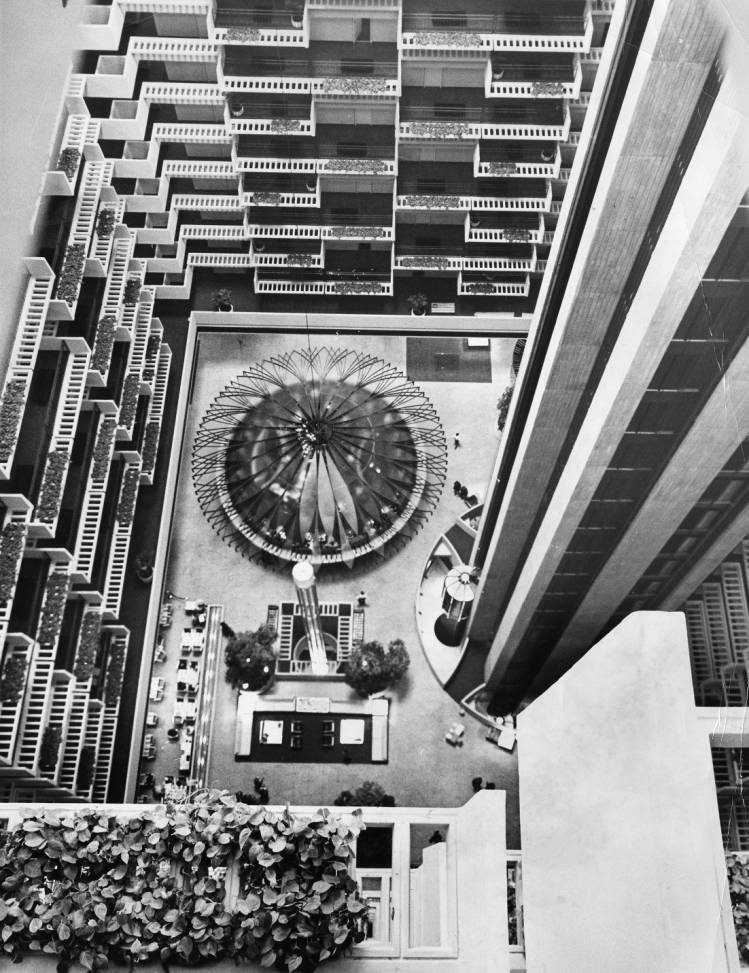
In 1965, long before the Hyatt, Portman had first experimented with an exploded atrium when he built the eight-story Antoine Graves Homes, a public housing project for elderly African Americans. Located just blocks southeast of downtown Atlanta, and across the street from what would eventually become the King Memorial MARTA station, Antoine Graves was Portman’s lone foray into public housing design during his long career. To prepare for the project, Portman had toured high-rise public housing projects and did not like the idea of people “being housed in boxes without air conditioning.” Portman sought to design a building that would encourage social interaction and provide residents refuge “from the congestion of urban life.” One of the ways he attempted to do this was via an atrium, with large rooftop fans and skylights to let in natural light and allow for cross-ventilation. The atrium insulated residents from the street, while providing an effective interior public courtyard space with balconies and seating areas. As one Graves resident explained of the atrium’s value, “I can be by myself when I want to be by myself, and I can be with others when I want to be with others.” 23 Portman, of course, did not invent the idea of including more access to light and air in modern urban living space. In New York City, the late nineteenth-century “dumbbell” tenement design marked a much earlier, if flawed attempt to give poor urban apartment dwellers a shaft of natural light and fresh air in response to the ills of dark, overcrowded, and dirty tenement life which Progressive era muckraker Jacob Riis had publicized in his turn of the century exposé How the Other Half Lives. However, Portman’s interior atrium plan at Antoine Graves was more likely a reaction against the massive, federally subsidized public housing complexes built in the 1950s and early 1960s. Critics of these high rises were just beginning to decry how the structures concentrated impoverished residents into a vertical ghetto and isolated inhabitants from the rest of the city, although in the early 1960s few knew just how deeply the projects would become associated with crime, drug use, and multi-generational poverty.24
Portman recognized that Antoine Graves Homes residents needed such a refuge, but it would be his first and last work on public housing in the city, and many Atlantans well aware of Portman’s architectural footprint in downtown Atlanta never knew that he built low-income housing. Portman himself rarely discussed the Antoine Graves atrium when reflecting upon the Regency Hyatt House, or the later variations of the hotel and atriums he built across the country. It is unclear why Portman stopped with Antoine Graves. Undoubtedly, lenders were more willing to support commercial projects with willing corporate sponsors. But it is also true that Portman partially bought into the idea that large populations of poor African American populations, living in public housing near the Central Business District, would bring increases in crime and deter businesses from staying in downtown Atlanta. As president of the pro-business Central Atlanta Progress in the early 1970s, Portman would support proposals to demolish public housing in favor of commercial and office development.25 In terms of sheer impact, Portman understood that bigger projects had the capacity to transform downtown Atlanta in a way that a building single housing structures piecemeal could not.26
Whatever the case, in committing to build public housing, Portman lost much of the autonomy he enjoyed as both architect and developer in his other projects.27 With the completion of the Peachtree Center complex, Portman reiterated the idea that his structures provided relief “from the congestion of urban life.” The types of structures Portman chose to include in his Center stipulated for whom “relief” was meant: out-of-town shoppers, convention goers, and office workers from the suburbs, all visiting occupants, and most with easy escapes from congested urban life already.
“Reorganizing of the Central City”
With a few completed buildings under his belt, Portman began to assert, ambitiously, that his chief professional concern in Atlanta was the “reorganizing of the central city.”28 Once Portman found a buyer for his hotel, he moved to acquire the city block immediately south of it along Peachtree Street. The two‐acre property provided him with enough room to create four more office buildings around a central exterior courtyard and shopping gallery. Portman borrowed heavily from the architectural elements in his first office building and was able to create a consistent design across these structures. Dreaming of his Peachtree Center complex as Atlanta’s equivalent of world-renowned Rockefeller Center in New York City, Portman sought to create a multi-acre campus of interconnected, multi-use buildings, tied together with unified architectural themes instantly recognizable to pedestrians and car drivers alike. Portman kept a big model of his “city within a city” in his offices.
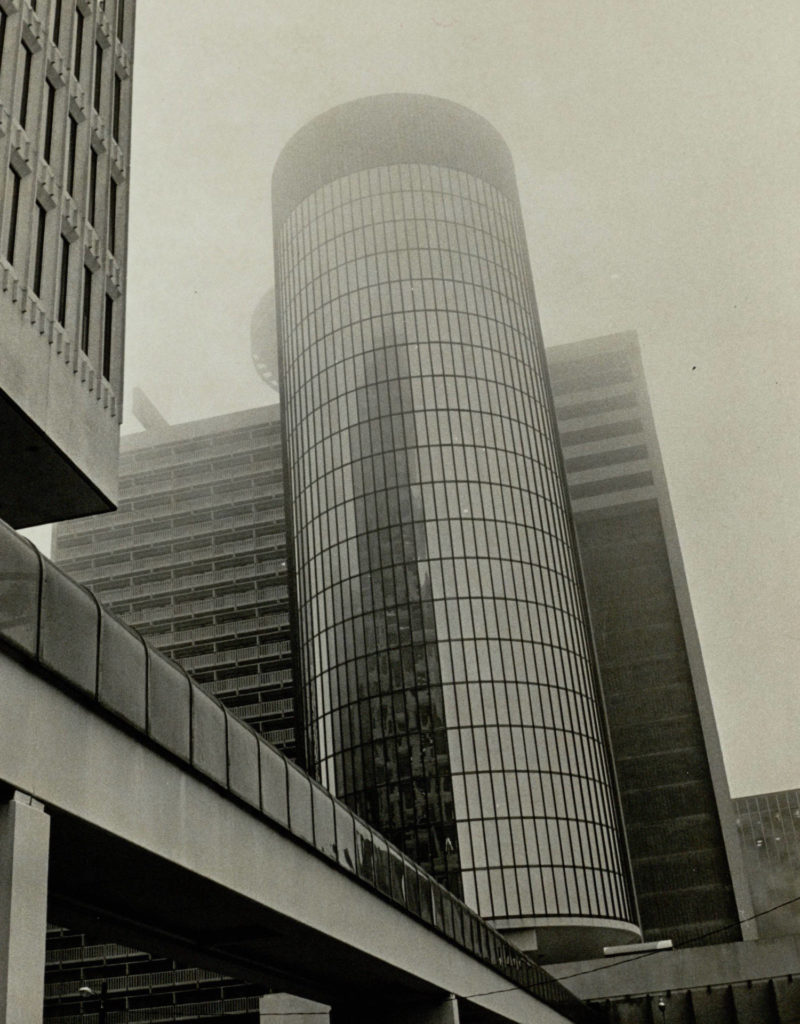
Then, in March 1976, Portman celebrated the grand opening of the eighth building in his Peachtree Center complex – the Peachtree Plaza, a fifty million-dollar, seventy story, cylindrical glass marvel of a hotel – which would serve as the RCA‐like tower in Portman’s southern Rockefeller Center, effectively capping off the southern boundary of his “city within a city.” With its seven‐story atrium that included a half‐acre lake, the Peachtree Plaza was lauded as Portman’s “encore.”29 In commenting on the opening, Portman again emphasized his joint role as architect and developer, and he boasted that he began plans for the Peachtree Plaza as he always did, “by examining the over-all studies of Atlanta’s needs,” as well as noting that he was motivated by “a desire to make whatever we build a contribution to man.”30
Placing Portman’s development within the larger historical context helps to explain his rationale, desires, and motivations. Portman’s transformation of the northeastern corner of downtown Atlanta took place amid the Civil Rights Movement, just as the city witnessed a massive outmigration of affluent whites and blacks to the suburbs on the Northside and to the south and west, respectively. Well-to-do white Atlantans had been fleeing to new, racially homogenous neighborhoods on the Northside even before civil rights legislation dismantled segregation by law in the mid-1960s.31 This outmigration continued apace in the early 1970s, especially after the city reached a compromise on how to go about integrating the Atlanta public school system.32 White Atlantans of means, fearing that an integrated school system would lower the quality of education, fled to new neighborhoods on the Northside in the hopes of maintaining the all-white school experience and left working class white neighborhoods to bear the brunt of desegregation. At the same time, affluent members of the African American community in Atlanta had been in search of new areas for residential expansion for decades, and civil rights legislation had finally helped to break down racial residential barriers. Many leaders in Atlanta’s African American professional class pointed to their stately suburban homes south and west of the city as proof that the civil rights movement had succeeded in bringing a more equitable measure of economic prosperity to blacks in the South, even though the experience of the city’s poorer African Americans living in or near urban renewal projects suggested otherwise.33
The plans for Peachtree Center arrived in Atlanta at a crucial moment of outmigration of the city’s entire middle class – black and white alike. Consequently, the Atlanta Chamber of Commerce and Central Atlanta Progress supported Portman’s project and others like it, such as Tom Cousins’ Omni International, hoping that such proposed complexes might stem the flight of affluent whites and blacks (and their wallets) from the city limits in the post-Jim Crow era. Moreover, Portman and other developers had to contend with white suburbanites’ increasingly racialized perceptions of downtown, especially following the 1973 election of the city’s first black mayor, Maynard Jackson. In a series entitled, “The City in Crisis,” Atlanta Constitution editor Jack Tarver had fanned the flames of white suburban anxiety and reinforced suburban perceptions of an increasingly black downtown as dirty, dangerous, and unsafe.34 As a result of such coverage, Portman and other developers became concerned that misperceptions of downtown would reach a critical mass, after which point no amount of clever advertising and boosterish marketing would be able to woo white suburbanites back into the city.
But though Portman argued that a healthy and revitalized downtown would have a balanced mix of incomes and classes, his Peachtree Center, when complete, would cater almost exclusively to affluent white-collar suburbanites and well-to-do out-of-towners. 35 Central to Portman’s efforts to woo such suburbanites back to the downtown was the designed insularity and isolation of the Plaza and Peachtree Center as a whole, as he noted that “the total effect, we hope, is to create a city within a city,” suggesting to those afraid of downtown and the implied racial violence therein that Peachtree Center was a safe haven, protected from the downtown that surrounded it.
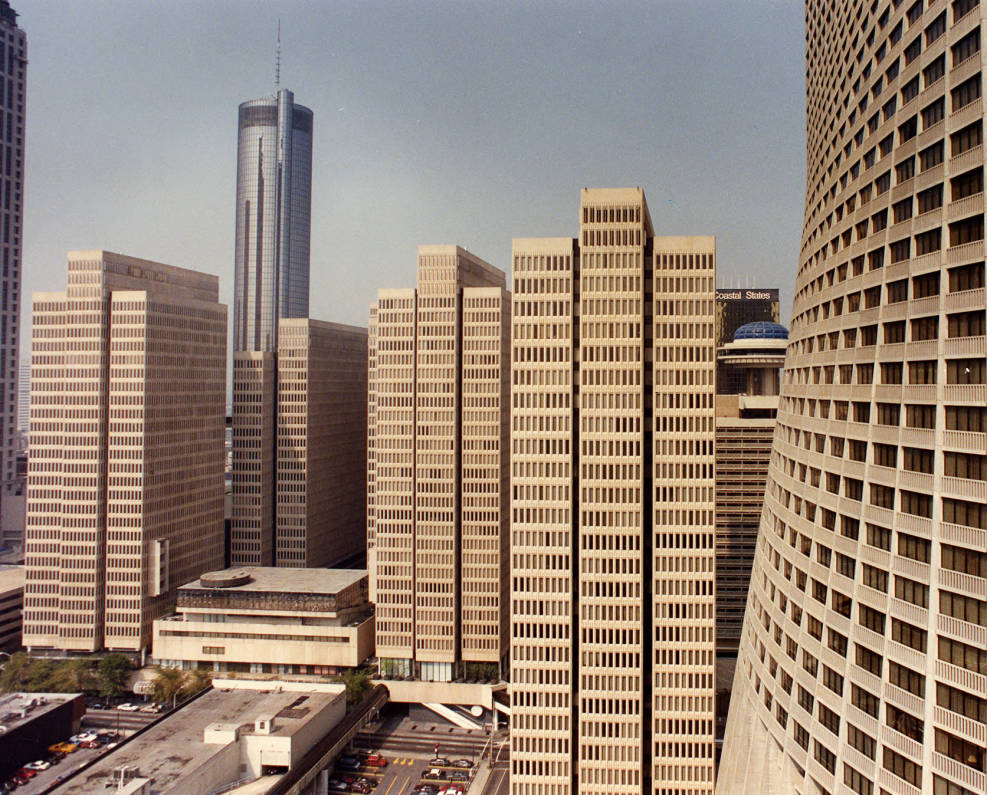
The Center’s office buildings and their nearly identical architectural facades clearly denoted the confines of the complex. While the four office towers became the city’s new prestigious business address, if one did not have an occasion to work or entertain inside Peachtree Center, the complex was a confusing and intimidating maze to navigate, which subconsciously or intentionally forced pedestrians to question whether they in fact belonged in the Center. Moreover, Portman proudly boasted that it was possible to travel the length and width of the entire Center without ever stepping on a sidewalk or crossing a street. The architect-developer had designed over a dozen pedestrian sky bridges that connected each of the Peachtree Center buildings to one another. Portman’s critics, pointing to his sky bridges, accused him of creating “fortress architecture,” which avoided the streets outside and implied that downtown itself was “congested and polluted at best, and unsafe from criminal elements at worst – a sentiment generally regarded as a code word for blacks.”36 The pedestrian sky bridges served as the physical manifestation of a two-class society in which white-collar workers, tourists, and conventioneers walked the bridges but the urban poor, who had no reason to venture inside the Center, were left to the streets. Consequently, critics questioned how effective Portman was at revitalizing the city, as it was entirely possible that Peachtree Center patrons could enter and leave without ever coming into contact with the city streets outside.37
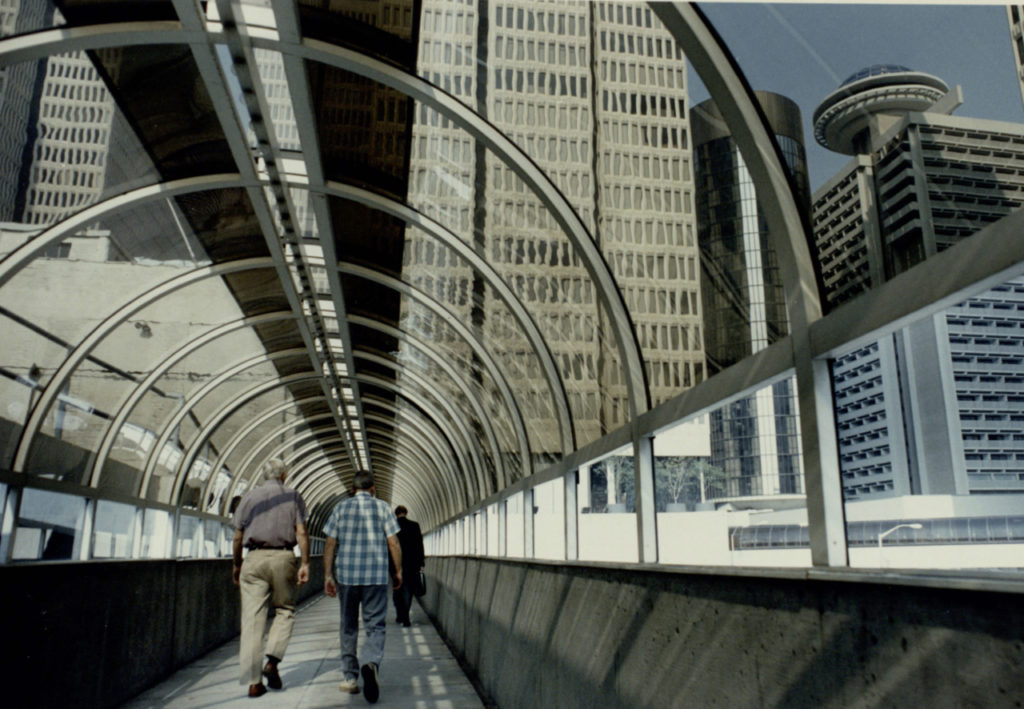
Conclusion
Did Portman’s Peachtree Center “succeed” in revitalizing downtown Atlanta, particularly in comparison to federal renewal programs? The answer to this question depended upon, and indeed, still depends upon, one’s definition of what a revitalized city should look like. Acting as architect and developer, Portman could lay claim to the fact that he was able to amass vast downtown acreage and construct nearly a dozen buildings between 1961 and 1976. One cannot help but compare the early progress of Portman’s Peachtree Center with nearby urban renewal projects, especially the Bedford Pine project in the Buttermilk Bottoms neighborhood, which sat three blocks to the east and two blocks to the North and became the site of the controversial Atlanta Civic Center, completed in 1967. The Civic Center displaced thousands of African Americans in Buttermilk Bottoms and removed local schools and churches. As a result, local displaced residents rioted, both near the Civic Center, and weeks later in nearby Summerhill. The Summer of 1966 riots, when remembered at all, are remembered primarily as a response to a shooting of an unarmed black man or due to outside agitation from Stokely Carmichael and other Student Nonviolent Coordinating Committee workers, but in reality, these neighborhoods were primed for protest in part because of the city’s long-standing failure to build affordable replacement housing in them.38 Though city planners and city alderman were seen as figures who had a responsibility to consider and respond to neighborhood discontent for the Civic Center, citizens could not expect the same audience with or response from Portman concerning his private construction projects, which meant that Portman could pursue his “city within a city” vision without having to accommodate community input.
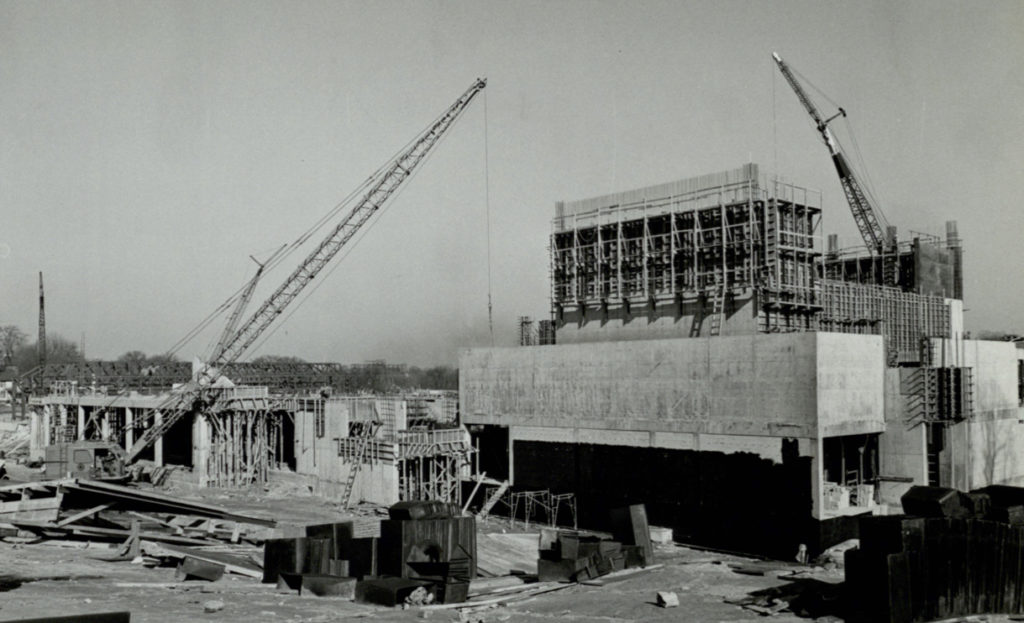
While successful in terms of constructing buildings, Portman’s prescription for revitalizing the inner city was problematic for a couple reasons. First, his projects excluded the very people most in need of urban revitalization. It was clear from Portman’s work with the Antoine Graves homes that Portman understood that all Atlantans were affected by the “congestion of urban life,” yet from the time Portman had first begun acquiring land near the Mart, his plans for the Peachtree Center never included any permanent affordable housing. Tens of thousands of poor Atlantans who had been displaced by urban renewal project sites would have clearly benefitted from affordable housing built near downtown, and near the Peachtree Center. It was not that Portman did not envision a residential component to his complex, as his preliminary plans called for upscale apartments within the Center.39 But building in order to reinvigorate the downtown business district necessarily conflicted with building housing for a poor, primarily minority population, because the predominantly white business coalition that governed Atlanta perceived poor and African American populations as inherent deterrents to stable property values and economic growth.40 That the influential Portman acquiesced to this rationale, rather than challenge it, suggests that he bought in to the idea that the poor had no place in a revitalized downtown Atlanta. Indeed, Portman even posited that Atlanta could have the greatest downtown in the United States if only more private businesses joined in Peachtree Center‐type complexes.39 In suggesting the superiority of the “Peachtree Center” model of urban revitalization while neglecting to acknowledge how that model ignores the plight of poor African Americans living in and near downtown Atlanta, Portman personifies much of Atlanta’s pro-business “city too busy to hate” ethos.41
Second, the size and scale of Peachtree Center relative to the entire downtown Atlanta skyline won Portman an outsized influence in determining the direction that urban revitalization in Atlanta would take. By not having to adhere to federal renewal program regulations, Portman more easily assembled private financing, did not have to submit plans through multiple channels for approval, did not have to listen to local city officials or neighborhood residents, was able to implement the design of his choosing, and did not have to weigh bids before building. In terms of the built environment, Portman completely remade Atlanta’s skyline and left a more visible imprint on the city than all urban renewal and model cities project sites put together. And in so doing, Portman’s new city skyline suggested that privatized renewal worked more effectively than federal programs. His ability to transform the physical space of downtown Atlanta thus afforded Portman specifically, and private developers more generally, subsequent greater influence over how downtown Atlanta would develop in the future, and shifted ideas about who downtown Atlanta was for.
Portman’s projects brought money, and money bought influence, with the Atlanta Chamber of Commerce, Central Atlanta Progress, and City Hall. The more Portman built, the more power he gained to get future projects built. His inclination to eschew federal urban renewal funding, or to prefer commercial projects over residential, especially low income residential projects, mattered. He cast a long shadow and influenced future generations of developers and distressed City Halls. His architect-developer influence was not limited to Atlanta alone. Though not the lone pioneer in devising the insular urban office park concept, Portman’s prescription to create a “city within a city” (and the accompanying suggestions of who downtown should be for) can be seen in his privately funded urban redevelopment plans to shore up other declining downtowns, namely, in Detroit’s Renaissance Plaza and San Francisco’s Embarcadero Center, where we see similar “fortress architecture” motifs, replete with skywalks and arcades protecting the white collar businessman or conventioneer from the poor people of color outside the center’s walls. By the mid-1970s, cities and the nation had shifted toward private revitalization efforts. The federal government phased out funding specifically designated for urban renewal and instead awarded broad-based community development block grant funding to states. Neighborhood advocates in cities across the country found themselves increasingly unable to compete with well-funded pro-business developer groups and the commercial interests they promoted.
Ultimately, though, internationally renowned Dutch architect, urbanist, and Portman critic Rem Koolhaas hit upon what is perhaps most problematic about Portman’s “Peachtree Center prescription” to revitalize downtown Atlanta, and downtowns everywhere. Portman had been successful at creating a “city within a city,” a complex completely isolated and cut off from the city itself, albeit a “city for others,” i.e. suburbanites and tourists. Regarding the atrium – the very architectural device that originally made Portman famous – Koolhaas posited: “At first, the atrium seemed to help rehabilitate and stabilize Atlanta’s downtown, but it actually accelerated its demise.” For, as Koolhaas explains, “with atriums as their private mini-centers, buildings no longer depend on specific locations. They can be anywhere. If they can be anywhere, why should they be downtown?”42
Portman believed he was innovative and revolutionary by focusing on downtown development when others were looking to the suburbs, but in building a complex that simultaneously ignored those in need of revitalization while assuaging the racialized fears of whites commuting to downtown, Portman’s Peachtree Center was in fact completely disconnected from a sense of place. There is nothing quintessentially downtown, or even Atlantan about Peachtree Center. With nothing tying the complex to downtown, Koolhaas reasoned, Portman showed future developers the irrelevance of building in downtown itself, and paved the way to a “proliferation of quasi-downtowns” or “edge cities” that further proved downtown’s obsolescence.43 In Portman’s Peachtree Center, just as with federal urban renewal programs, what remained to be seen was an attempt at urban revitalization that successfully attracted and served all Atlantans – white and black, affluent and impoverished. In spite of the successful constructions of Portman’s developments, we should not forget that they represent only Portman’s vision of how a revitalized downtown Atlanta should look and failed to give equal voice and weight to city officials, downtown business boosters, and neighborhood housing advocates and their respective visions of what a revitalized city should look like, and whom it should serve.
This work is licensed under a Creative Commons Attribution-NonCommercial-NoDerivatives 4.0 International License. Attribution must provide author name, article title, Atlanta Studies, date of publication, and a link to this page. Note that this license applies only to the text of the article, not to media used here by permission.
Cover Image Attribution: Peachtree Center. Manning, Selvage and Lee Forward Atlanta Campaign Photographs Collection at Kenan Research Center at Atlanta History Center. Courtesy of Atlanta History Center.
Citation: Way, Iren Holliman. “”Creating a City Within a City”: John Portman’s Peachtree Center and Private Urban Renewal in Atlanta.” Atlanta Studies. January 15, 2019. https://doi.org/10.18737/atls20190115
Irene Holliman Way is a lecturer at Kennesaw State University in Kennesaw, Georgia, where she teaches lots of introductory classes in American History from Civil War to the present.
- Ada Louise Huxtable, “Energized Atlanta: City on The Move,” Atlanta Journal and Constitution, May 5, 1974, 12A.[↩]
- Irene V. Holliman, “From Crackertown to Model City? Urban Renewal and Community Building in Atlanta, 1963–1966,” Journal of Urban History 35, no. 3 (March 2009): 369–86, https://doi.org/10.1177/0096144208330402.[↩]
- Walter McQuade, “Atlanta, the Hopeful City,” Fortune 74 (August 1966): 155–6, 160, 162.[↩]
- Rodney Cook to John Portman, June 22, 1967. Rodney Cook papers, Series II, Subseries B, Box 5, Folder 8, Richard Russell Library, University of Georgia.[↩]
- Rex Granum, “Portman: Asks City Show Way,” Atlanta Constitution, May 8, 1973, 8B.[↩]
- Patrick Sisson, “Neofuturist Architect John Portman Bet on Cities Just as People Fled Them,” Curbed, August 26, 2016, https://www.curbed.com/2016/8/26/12663306/architecture-john-portman-hyatt-atlanta-atrium.[↩]
- On downtown revitalization designed for tourists, see: Dennis R. Judd, “Constructing the Tourist Bubble,” in Dennis R. Judd and Susan S. Fainstein, eds., The Tourist City. (New Haven: Yale University Press, 1999), 35–53. For more on how Atlanta city leaders and developers specifically conceived of tourist bubble components and how they dealt with questions of race within their developments, see: Harvey K. Newman, “Race and the Tourist Bubble in Downtown Atlanta,” Urban Affairs Review, 37, 3 (2002): 301–21.[↩]
- John Portman and Jonathan Barnett, The Architect as Developer (New York: McGraw‐Hill, 1976).[↩]
- For background on how and why the federal Urban Renewal program started, see: James Q. Wilson, ed., Urban Renewal: The Record and the Controversy (Cambridge, MA: MIT Press, 1966). There are dozens of studies that examine the successes and failures of urban renewal programs in American downtowns. For an examination of Atlanta specifically, see: Clarence N. Stone, Economic Growth and Neighborhood Discontent: System Bias in the Urban Renewal Program of Atlanta (Chapel Hill: University of North Carolina Press, 1976).[↩]
- Portman and Barrett, The Architect as Developer, 30.[↩]
- Lane was an odd advocate for the use of private funding here. In the late 1960s, during Mayor Ivan Allen’s administration, the same Mills Lane had the mayor create the Atlanta–Fulton County Recreation Authority and Lane orchestrated the use of city (i.e. public) recreation authority tax funds to pay for the city’s major league stadium construction. For more on Mills Lane and earlier stadium urban renewal, see: Larry Keating, Atlanta: Race, Class, and Urban Expansion (Philadelphia: Temple University Press, 2001): 98–9.[↩]
- Portman and Barnett, The Architect as Developer, 25–6; Jonathan Barnett, “John Portman: Atlanta’s One Man Urban Renewal Program,” Architectural Record (January 1966), 133–40.[↩]
- John Portman, “Architecture for People, and Not for Things,” Architectural Record (January 1977), 133.[↩]
- McQuade, “Atlanta, the Hopeful City,” 160, 162.[↩]
- William Martin, “Urban Growth: Atlanta Does it Right,” Christian Science Monitor, May 19, 1975, 14–5.[↩]
- Bernard Leitner, “John Portman: Architecture is Not a Building,” Art in America 61 (March/April 1973): 80–2; “Learning from Atlanta,” AIA Journal 63 (April 1975): 37. Ironically, in 2016, the first Peachtree Center office building at 230 Peachtree Street was renovated to become a new franchise in the Hotel Indigo chain. The exterior remains the same as all of the other Peachtree Center towers, and the atrium is utterly underwhelming compared to Portman’s earlier hotel work.[↩]
- Portman and Barnett, The Architect as Developer, 28; Barnett, “John Portman,” 137.[↩]
- Portman and Barnett, The Architect as Developer, 30.[↩]
- Barnett, “John Portman,” 136.[↩]
- Ibid, 137; Portman and Barnett, The Architect as Developer, 28[↩]
- Ibid. For Portman in his own words describing the effects of an exploded lobby and huge atrium space, see: Paul Goldberger and Paolo Riani, John Portman (Washington, DC: The American Institute of Architects Press: 1990), 78–81; Mohsen Mostafavi, Portman’s America & Other Speculations (Cambridge: Harvard University Graduate School of Design and Lars Müller Publishers, 2017), 31, 128–39.[↩]
- Leitner, “John Portman: Architecture is Not a Building,” 81; Interview with Andrew Young, May 30, 2007.[↩]
- Maria Saporta, “Portman’s First Atrium Building to Be Torn Down,” Atlanta Business Chronicle, October 9, 2009; Barnett, “John Portman,” 133.[↩]
- The most influential academic critiques of high rise public housing were not published until the 1980s and early 1990s. For example, see: Arnold Hirsch, Making the Second Ghetto: Race and Housing in Chicago (Chicago: University of Chicago Press, 1985). But developers such as Portman would have been familiar with arguments that public policy played a large role in reinforcing post-Jim Crow segregation and perpetuating concentrated poverty. Hirsch refers to the critiques available around the time Portman was building Antoine Graves as initial “ghetto” studies. For an example of those, see: Gilbert Osofsky, Harlem: The Making of a Ghetto, 1890–1930 (New York: Harper and Row, 1963).[↩]
- Keating, Atlanta: Race, Class, and Urban Expansion, 176.[↩]
- The Atlanta governing coalition of business and City Hall had, since Ivan Allen’s tenure as mayor (1961–70), sought to project a more integrated urban plan that would attract national and international business. For more on what this meant to developers, see: Charles Rice, Interior Urbanism: Architecture, John Portman and Downtown America (London: Bloomsbury Academic Press, 2016), 49–62.[↩]
- By the early twenty-first century, the Antoine Graves Homes were considered outdated and were in need of asbestos removal. In 2008, a tornado cut through downtown Atlanta and irrevocably damaged the building, forcing its remaining senior residents to move. (Incidentally, the tornado also ravaged Portman’s Peachtree Plaza.) Portman pleaded with the city to save the building but did not offer any money or woo any financial support to do so, and the Antoine Graves Homes were demolished in late 2009.[↩]
- “Portman: A New Force for Rebuilding the Cities,” Business Week, February 17, 1973, 58–64.[↩]
- Bruce Galphin, “John Portman’s Encore,” Atlanta Magazine, November 1972.[↩]
- “High Rise, High Fashion, High Hopes, High Stakes,” Atlanta Journal Constitution Magazine, February 8, 1976, 24.[↩]
- For the most comprehensive look at the reasons behind and the effects of white out-migration in Atlanta, see: Kevin Kruse, White Flight: Atlanta and the Making of Modern Conservatism (Princeton, NJ: Princeton University Press, 2005).[↩]
- See: Kruse, White Flight, 131–60.[↩]
- On black suburbanization in Atlanta, see: Andrew Wiese, Places of their Own: African American Suburbanization in the Twentieth Century, (Chicago: University of Chicago Press, 2005); on African American attempts to expand racial residential barriers in Atlanta, see also: Ronald Bayor, Race and the Shaping of Twentieth Century Atlanta, (Chapel Hill: University of North Carolina Press, 1996).[↩]
- Atlanta Constitution, March 15–25, 1975.[↩]
- For examples of downtown Atlanta serving the out-of-town convention goer, see: Harvey K. Newman, “Race and the Tourist Bubble in Downtown Atlanta.”[↩]
- Tom Walker, “Skybridges High, Dry, Debatable,” Atlanta Journal, September 6, 1988 1B; “Learning From Atlanta,” 38; Rutheiser, Imagineering Atlanta, 162.[↩]
- Walker, “Skybridges High, Dry, Debatable.”[↩]
- Holliman, “From Crackertown to Model City?” 379–81.[↩]
- McQuade, “Atlanta, the Hopeful City,” 74.[↩][↩]
- For examples of how white Atlantans perceived African American populations as deterrents to stable property values and economic growth, see Bayor, Race and the Shaping of Twentieth-Century Atlanta; Keating, Atlanta: Race, Class, and Urban Expansion; Stone, Economic Growth and Neighborhood Discontent; Kruse, White Flight: Atlanta and the Making of Modern Conservatism.[↩]
- In the 1950s, Mayor William Hartsfield dubbed the city of Atlanta “too busy to hate” before quietly desegregating the city’s public golf courses. A jab at neighboring cities like Birmingham, Hartsfield desegregated not because it was the right thing to do, but rather because he did not want any racial violence or bad publicity to hurt Atlanta business.[↩]
- Rem Koolhaas, “Atlanta,” in Shaping the City: Studies in History, Theory, and Urban Design, eds. Rodolphe El-Khoury and Edward Robbins (New York: Routledge, 2013), 8.[↩]
- Ibid; Joel Garreau, Edge Cities: Life on the New Frontier (New York: Doubleday, 1991).[↩]

